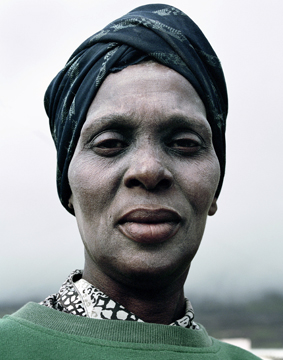
Jackie Nickerson
Irish, 1960- (active Africa)
Grandmother , 2004
Lambda photograph, ed. 4/4
SBMA, Museum purchase with funds provided by PhotoFutures
2008.17

Jackie Nickerson in self-portrait
"I began to photograph the workers as I recognized their affinity with their environment. Their pride and dignity were unaffected by encroaching materialism; they existed within strong structures of family, tribe and community and they were well educated, welcoming, and very hardworking." - Nickerson
RESEARCH PAPER
In the 1990s Jackie Nickerson became a well known and sought after fashion photographer working out of New York, Milan, and Paris. But in the summer of 1997, while visiting friends in Zimbabwe, Nickerson discovered the beauty of Africa and its people. Nickerson eventually bought a flat bed truck and drove around rural Mozambique, Malawi, Zimbabwe, and South Africa photographing farm workers and landscapes.
In 1994 Nickerson's photographs of Africa were compiled into a book that she titled Farm. Our photograph, Grandmother, Masiphumelele Township, is the cover photo for Farm.
In our photograph the grandmother from Masiphumelele Township looks out proudly at the world. She is powerful and large, although not threatening. One can see from her clothing that she is not a wealthy woman. But her eyes show her as a woman of substance and grace. One can see the similarities with the way this photograph was composed and the composition of high fashion photographs with which Jackie Nickerson was so familiar. Unlike fashion photography, here the woman's wrinkles and skin texture are highlighted, not airbrushed, giving the photograph unusual clarity and texture. In the cloth of the headscarf, for example, one can see the individual threads of the weave. In contrast, the background is so unfocused as to be unrecognizable forcing the viewer to concentrate on the woman. Nickerson wrote "if you want to look inside somebody, if you want to see something coming out of the person, you've got to keep things really simple." In our photograph, Nickerson kept the photograph simple and focused and in so doing, she portrays strength and dignity with commanding power.
Our grandmother from Masiphumelele Township is probably a Xhosa woman. On her face is the white clay traditionally worn by Xhosa people for spiritual or decorative reasons or simply for protection from the sun. She also wears a turban, the traditional head covering of a married Xhosa woman.
Masiphumelele Township is a settlement on the outskirts of Capetown, South Africa. The township began in the 1980s when a group of 400-500 black South Africans moved into the area illegally to live in the bushes near where they worked. Under the Apartheid regime, these families were forcibly removed and told they had to live at another site more than 30 kilometers away. At the end of Apartheid, black South Africans, primarily from the Xhosa tribe, moved into the area, then known as "Site 5." The people soon renamed their township Masiphumelele, a Xhosa word meaning "we will succeed." By 1990, 8000 people lived in Masphumelele and by 2008 the population had swelled to at least 24000 people. It is estimated that 30-40% of the people of the township are infected with HIV and/or TB. Crime and malnutrition remain problems. And in August 2006, residents looted and destroyed Somali immigrant owned businesses during a wave of xenophobic violence that rocked Western Cape Province.
After publishing Farm, Nickerson focused her camera on cloistered Catholic religious communities in Ireland. To convince the orders to let her inside their communities, Nickerson said she would show them Farm and explain that the pictures are "about the dignity of the poor and how they don't have to have a lot in life in order to give and be inspirational and be a whole person." Nickerson believes that Farm ultimately gave her entrée into the world of the Irish cloisters and led to her book Faith published in 2007.
Nickerson lives in rural Ireland with her husband where she awaits publication of her third book, Domicile. She also continues to do photojournalism work for the New York Times Magazine. In 2008, Nickerson won the Allied Irish Bank Prize, an award that recognizes emerging Irish artists. Nickerson is represented in the United States by the Jack Shainman Gallery, New York, New York.
Prepared for the Santa Barbara Museum of Art Docent Council by Molora Vadnais, March 4, 2009.
Bibliography
Allied Irish Banks. www.aibgroup.com/servlet/Satellite?c=CSRContent , 2009. (for photograph of Jackie Nickerson.
Baldwin, Rosecrans. Faith . www.themorningnews.org/archives/galleries/faith , October 14, 2007.
Bergner, Daniel. The Call . New York Times Magazine . January 29, 2006., p. 29.
HOKISA, History of Masiphumelele . www.hokisa.co.za , 2009.
IRIN (UN office for the Coordination of Humanitarian Affairs). SOUTH AFRICA: Fleeing war, Somalis are targets of violence in adopted home. www.irinnews.org , October 10, 2006.
Jack Shainman Gallery. www.jackshainman.com , 2009.
Nickerson, Jackie. Faith . G?ttingen, Germany: SteidlMACK, 2007.
Nickerson, Jackie. Farm . London: Jonathan Cape, 2002.
Nickerson, Farm . p. 7.
Nickerson, Faith . Conversation with Vince Aletti.
Ibid .
